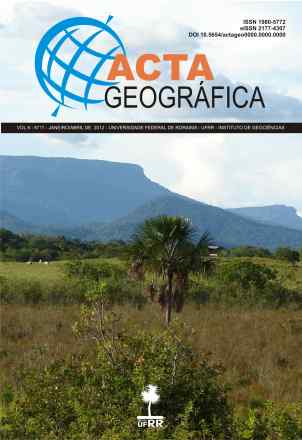KANT, GOETHE E ALEXANDER HUMBOLDT: ESTÉTICA E PAISAGEM NA GÊNESE DA GEOGRAFIA FÍSICA MODERNA
Revista Acta Geográfica
KANT, GOETHE E ALEXANDER HUMBOLDT: ESTÉTICA E PAISAGEM NA GÊNESE DA GEOGRAFIA FÍSICA MODERNA
Autor Correspondente: Antonio Carlos VITTE | [email protected]
Palavras-chave: estética, paisagem, protótipo, protofenômeno, teleologia da natureza, Geografia FÃsica
Resumos Cadastrados
Resumo Português:
Este trabalho procura apontar a confluência das idéias kantianas, goetheanas e humboldtianas de estética e paisagem na fundamentação da Geografia FÃsica Moderna. Em Kant trabalharemos com a construção de uma estética transcendental, pilar constituinte do projeto romântico da ciência humboldtiana e elemento primordial de uma nova noção de “formaâ€, além da perspectiva de uma natureza atuando segundo a fins; passando por Goethe, veremos como a paisagem assume um importante papel na nova explicação do mundo natural, antevendo na forma a sÃntese entre todo e parte e a face objetiva do protótipo e do protofenômeno; em Alexander Humboldt chegaremos ao nascimento de uma nova ciência, estruturada na concepção estética de uma forma representada por uma manifestação cientÃfico-artÃstica, além da apresentação de uma interdependência entre a esfera subjetiva e objetiva, permitindo o surgimento de uma paisagem não estritamente natural, mas geográfica. Todo este revolver epistemológico será tomado em nosso tempo, num universo de cânones envelhecidos e novas necessidades.
Resumo Inglês:
This paper tries to point out the confluence of Kantian ideas, and goetheanas humboldtiana aesthetic and landscape in the grounds of Modern Physical Geography. In Kant's work with the construction of an aesthetic transcendental pillar constituent of the romantic project of science and humboldtian key element of a new concept of "form", besides the prospect of a nature acting according to purposes; through Goethe, see how the landscape plays an important role in the new explanation of the natural world, anticipating the kind of synthesis between whole and part and meet the objective of the prototype and proto-phenomenon; Alexander Humboldt arrive at the birth of a new science, based on the conception of an aesthetic form represented by a scientific and artistic expression, beyond the presentation of an interdependence between the subjective and objective ball, allowing the emergence of a landscape not strictly natural, but geographical. All this epistemological revolver will be taken in our time, out of canons aged and new needs.

